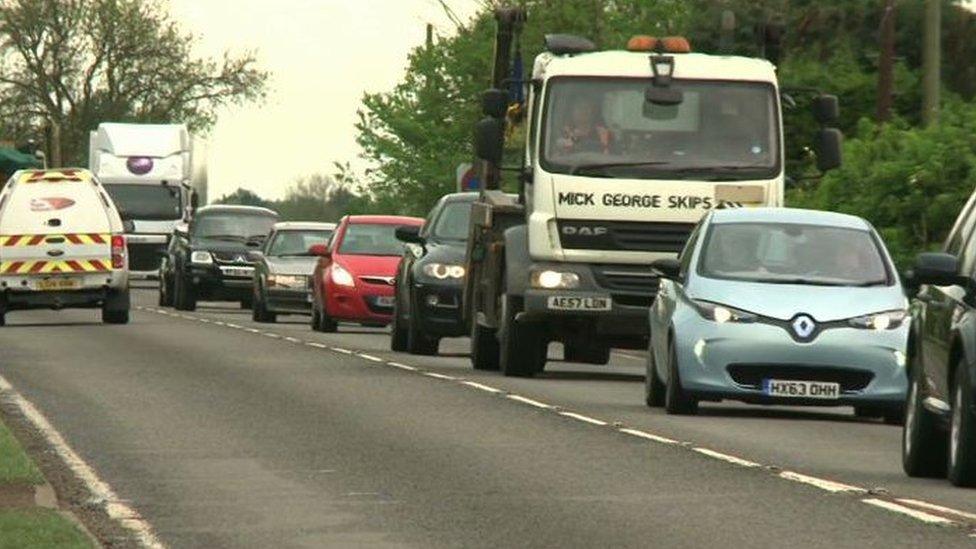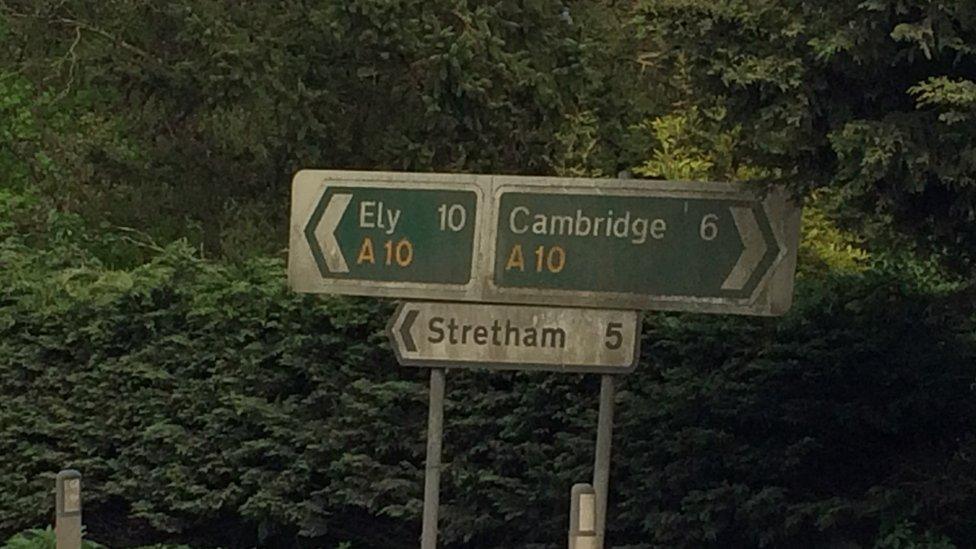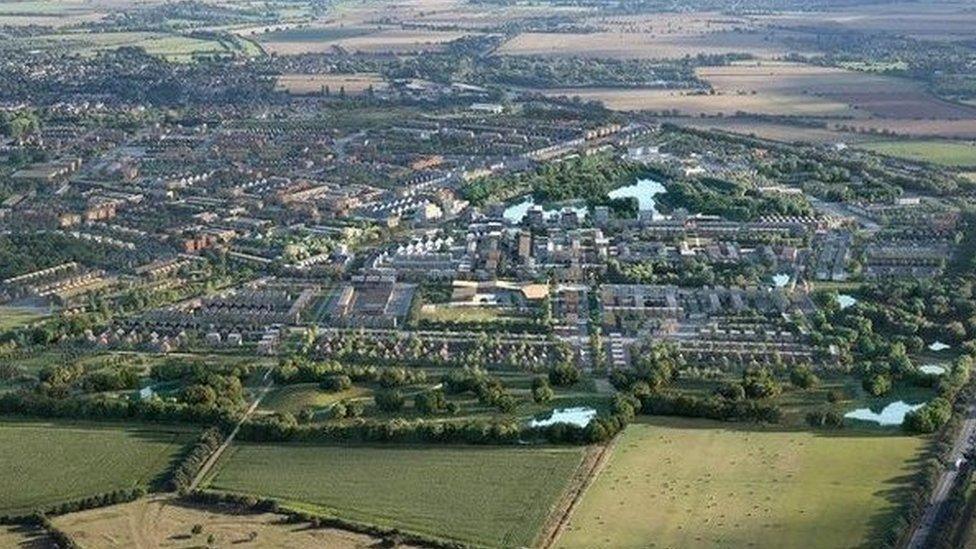Ely and the A10: What can be done to improve it?
- Published

The Ship of the Fens looms over the Ely skyline. But is this tiny city as well-connected as it should be?
The area between Ely and Cambridge is one of the fastest growing parts of the country but some say the road that links the two cities is "unfit" for purpose. Ahead of the mayoral election in the county, BBC News looks at what could be done to improve things.
It takes, on average, 45 minutes to travel the 16 miles (25km) between Cambridge and Ely on the A10. On a good day.
It is a flat, long, single carriageway road, with little opportunity to overtake, where regular intercity commuters jostle for position with HGVs, white vans and tractors.
Every day 18,000 vehicles travel along here between the university and cathedral cities. And the congestion could be set to worsen.
A public consultation has just ended into plans for 6,500 homes off the A10, on the former site of Waterbeach barracks - three miles north of Cambridge.
And the East Cambridgeshire Local Plan wants to see another 12,500 homes on a number of projects in and around Ely - including a major development in the north of the city.
Phil Robinson, who lives near Littleport, in Cambridgeshire, is fed up with being stuck in queues. He got in touch via Your Questions to ask us to investigate what the plans were on improving infrastructure in and around Ely.
He said improving access to the A14 and M11 from the A10 had been "disregarded by council after council for 30 years now".
"Making a journey that used to take 30 minutes now takes several hours," he said.
"Not all of the A10 traffic is heading into Cambridge - but may be heading for the A14 of the M11, either way they are stuffed. Enough is enough, and an upgrade is very much overdue.
"In my opinion there should be a complete ban on housing development along this corridor until the road upgrade is completed."

The A10: What the mayoral candidates say

The mayoral candidates, from top left: Rod Cantrill (Lib Dem), Peter Dawe (Independent), Kevin Price (Labour), Julie Howell (Green Party), Stephen Goldspink (English Democrats), Paul Bullen (UKIP) and James Palmer (Con)
Paul Bullen, UKIP: "The A10 should be dualled. The money earmarked for transport from the mayoral budget is not enough to put right what is wrong with all our roads. I will push for a proper analysis of our roads and prioritise. There are so many issues: filling potholes, straightening pavements, sorting traffic lights and speed limits. What we need is a complete and major briefing of the bigger picture. This is a rural county and it's all well and good to push for better public transport but we have to be realistic."
Rod Cantrill, Liberal Democrats: "At the moment the county council is carrying out a full review which will not be available until June. I want an integrated transport strategy for the region, including rail, buses and cycling - and improving roads where needed. But simply dualling the A10 will create longer queues further down the line. I'm concerned about the impact on local communities like Stretham. If the A10 is dualled, where will all the traffic go?"
Peter Dawe, Independent: "The problem with the A10 starts at the junction with the A14 - it's about getting Cambridge moving. If we dualled the A10 as far as King's Lynn it would still be a car park. I believe the best way to improve it is to transform urban Cambridge - we need a 21st Century transformation - it has to be radical. The current thinking is not working."
Stephen Goldspink, English Democrats: "I would like to see a whole load of smaller improvements on the A10 towards Cambridge rather than full dualling, it doesn't need it. It isn't congested all the time - only in the rush hours. I'd like to see the pinch-points sorted but creating a dual carriageway would just encourage more to commute along it. The money needs to go on projects around the county - not just this."
Kevin Price, Labour: "The A10 needs improving and upgrading, however, dualling is not the answer. We need to get people out of their cars and on to buses. There are two few people in too many cars. It is like giving a teenager a second waste paper basket in their room - they won't empty the first, only fill the second."
James Palmer, Conservatives: "I will be putting together a business case for dualling the A10 between Cambridge and Littleport, as the status quo is simply not good enough. Apart from a couple of roundabouts it's been the same for 40-50 years. The railway is an option but it cannot take all the traffic. We have to upgrade the A10 and future-proof it."
Stuart Tuckwood, speaking for the Green Party: "Dualling or improving the A10 won't beat the congestion unless the road at either end is sorted out, at Cambridge and at Ely. We want to see much more investment in public transport as well as help and support for active transport, such as walking and cycling."


There are calls to upgrade the A10 corridor between Ely and Cambridge to cope with major housing developments nearby
Edward Leigh, of Smarter Cambridge Transport, a campaign group aiming to promote better transport solutions, is not in favour of dualling the A10.
"The A10 has two major problems," he said. "Congestion and safety. It needs a safety audit.
"It has a number of concealed junctions and a lot of farm traffic use it - it needs passing lanes and lay-bys and more filter lanes on the junctions to reduce localised congestion."
He added that widening the A10 would create a domino effect of greater traffic volume further down the road network.

The A10 between Cambridge and Ely is a single carriageway road that runs for 16 miles
The county council is also looking closely at the corridor between Ely and Cambridge, not just the A10 - but also rail, bus, pedestrian and cycle networks. It forms part of the so-called Cambridgeshire Long Term Transport Strategy - and the equally wordy Transport Strategy for Cambridge and South Cambridgeshire.
Among the ideas in the mix are plans to relocate Waterbeach station from the edge of the village and expand it to serve the new town - and take 12-carriage Thameslink trains. It is also looking at busway links from the new town to north Cambridge - and improving the Milton Interchange where the A10 ends and joins the A14.

A computer-generated image of what an expanded Waterbeach will look like in the future. About 6,500 homes are planned for the old barracks site